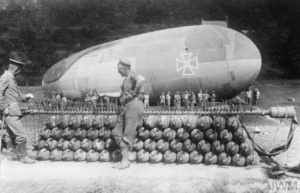Thursday June 6th, 1918
Laid in bed late and went over to Buckshee Camp for mail from Battalion. Three letters from home. Very hot. Shooting fish afternoon – good catch. Cook cooking them for breakfast. Mounted guard 6:45. Raining hard. Balloon at Yenikoi (pronounced yen.e.caye). Cilicol ?? plant
Food
A few days ago, Frank admired some Serbian soldiers shooting fish for food. Today Frank tries the technique for himself and has a ‘good catch’ which the cook then prepared for breakfast. He sounds pleased.
Hydrogen Gas Production
Frank also writes of the ‘Cilicol plant’ in his entry today. What he is making reference to is the manufacture of the hydrogen gas required for the kite balloons. There were a variety of techniques used, but for mobile units the one referenced by Frank was preferred by the RAF and its predecessors, the RNAS and the RFC. The process is described in the following extract:
‘The Royal Naval Air Service standardised on a more easily operated and flexible process: silicon was reacted with hot concentrated caustic soda solution yielding hydrogen and sodium silicate (‘water glass’). The silicon was available commercially as 90% ferrosilicon (roughly silicon 90%, iron 3.5%, aluminium 5.5%). It appears that at that time this material was known as “Silicol”, and that name was transferred to the hydrogen-making process. The generating equipment was simple, basically a stirred reaction vessel and a scrubber to remove steam and some water-soluble impurities. Use of commercial raw materials gave 99% pure hydrogen, and a high output could be obtained from a relatively small plant. Control of the reaction was said to be very easy. The standard small-size plant (2000 – 2500 cu.ft./hour) could be mounted on a lorry or in a ship.

Batch operation was necessary because the sodium silicate by-product, together with material derived from impurities in the raw materials, formed a sludge which rapidly solidified in the reactor. Very large quantities of water were required for reaction, scrubbing and cooling, although much of this requirement could be seawater
This process was also used by the Royal Flying Corps/RAF and it was used to fill the R100 airship, an operation which consumed 432 tons of reactants and produced 929 tons of sludge.’
Tanks and cylinders were used to store hydrogen, manufactured using this process and others. This image shows German ground crew filling a captured Allied observation balloon from a bank of gas cylinders.*
13th (Service) Battalion War Diary – 6th June 1918 – Sporan
Work and fatigues as before. The Horse Show ground are luckily quite close to the camp so that the fatigues are quite handy to their work. Tomorrow and Saturday are holidays from 14:00 hrs. Permanent working parties will parade as usual in the early morning but no evening work will be done. All available men will be allowed to attend the Horse Show.
References & Further Reading
¹ Article on Hydrogen Gas Production on the Nevil Shute Foundation website, reproduced courtesy of A.M. Burgess and Cleveland Industrial Archaeology Society.
² Article on renewed interest in hydrogen manufacture using silicon
* Q23912 copyright Imperial War Museums


